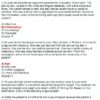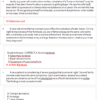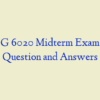Description
NSG 6020 Midterm Exam Question with Answers – South University (100 Question and Answers)
- When preparing to perform a physical examination on an infant, the examiner should:
- A patient’s laboratory data reveal an elevated thyroxine level. The nurse would proceed with an examination of the:
- The nurse practitioner is doing an oral assessment on a 40-year-old black patient and notes the presence of a 1-cm, nontender, grayish-white lesion on the left buccal mucosa. Which of the following is true concerning this lesion?
- During an examination, the nurse knows that Paget’s disease would be indicated by which of the following findings?
- A 30-year-old woman with a history of mitral valve problems states that she has been “very tired.” She has started waking up at night and feels like her “heart is pounding.” During the assessment, the nurse practitioner palpates a thrill and lift at the fifth left intercostal space midclavicular line. In the same area the nurse practitioner also auscultates a blowing, swishing sound right after S1. These findings would be most consistent with:
- The nurse practitioner notices that a patient’s submental lymph nodes are enlarged. In an effort to identify the cause of the node enlargement, the nurse would assess the:
- During an assessment of a newborn infant, the nurse practitioner recalls that pyloric stenosis would be manifested by:
- A patient has been shown to have a sensorineural hearing loss. During the assessment, it would be important for the nurse to:
- The most important reason to share information and offer brief teaching while performing the physical examination is to help:
- A patient’s thyroid is enlarged, and the nurse practitioner is preparing to auscultate the thyroid for the presence of a bruit. A bruit is a:
- During a cardiac assessment on an adult patient in the hospital for “chest pain,”
- the nurse practitioner finds the following: jugular vein pulsations 4 cm above sternal angle when he is elevated at 45 degrees, BP 98/60, HR 130; ankle edema; difficulty in breathing when supine; and an S3 on auscultation. Which of the following best explains the cause of these findings?
- When examining an infant, the nurse practitioner should examine which area first?
- An example of objective information obtained during the physical assessment includes the:
- The nurse practitioner is obtaining a history from a 30-year-old male patient and is concerned about health promotion activities. Which of the following questions would be appropriate to use to assess health promotion activities for this patient?
- The nurse practitioner notices that an infant has a large, soft lump on the side of his head and that his mother is very concerned. She tells the nurse practitioner that she noticed the lump about 8 hours after her baby’s birth, and that it seems to be getting bigger. One possible explanation for this is:
- A mother asks when her newborn infant’s eyesight will be developed. The nurse practitioner should reply:
- The temporomandibular joint is just below the temporal artery and anterior to the:
- The nurse practitioner notes the presence of periorbital edema when performing an eye assessment on a 70-year-old patient. The nurse practitioner will:
- During an examination of a patient in her third trimester of pregnancy, the nurse practitioner notices that the patient’s thyroid gland is slightly enlarged. No enlargement had been noted previously. The nurse practitioner suspects that:
- The mother of a 2-year-old is concerned because her son has had three ear infections in the past year. What would be an appropriate response by the nurse practitioner?
- In performing an examination of a 3-year-old with a suspected ear infection, the nurse practitioner would:
- A patient presents with excruciating headache pain on one side of his head, especially around his eye, forehead, and cheek that lasts about 1/2 to 2 hours, occurring once or twice each day. The nurse practitioner suspects:
- The nurse practitioner would use bimanual palpation technique in which situation?
- Percussion notes heard during the abdominal assessment may include:
- A patient complains that while studying for an examination he began to notice a severe headache in the frontotemporal area of his head that is throbbing and is somewhat relieved when he lies down. He tells the nurse practitioner that his mother also had these headaches. The nurse practitioner suspects that he may be suffering from :
- Which of the following statements regarding the aging adult and abdominal assessment is true?
- When preparing to examine a 6-year-old child, which action is most appropriate?
- In assessing the sclera of a black patient, which of the following would be an expected finding?
- In infants, the nurse practitioner knows to elicit the Moro reflex:
- A patient comes to the emergency department after a boxing match, and his left eye is swollen almost shut. He has bruises on his face and neck. He says he is worried because he “can’t see well” from his left eye. The nurse practitioner recognizes that signs of retinal detachment include:
- A patient states that she is unable to hear well with her left ear. The Weber test shows lateralization to the right ear. Rinne has AC>BC with ratio of 2:1 in both ears, left-AC 10 sec and BC 5 sec, right-AC 30 sec and BC 15 sec. What would be the interpretation of these results?
- When palpating the abdomen of a 20-year-old patient, the nurse practitioner notes the presence of tenderness in the left upper quadrant with deep palpation. Which of the following structures is most likely to be involved?
- When performing the physical assessment, the examiner should:
- A patient has been admitted to the emergency department with a possible medical diagnosis of pulmonary embolism. The nurse practitioner recognizes which assessment findings related to this condition?
- During a morning assessment, the nurse practitioner notes that the patient’s sputum is frothy and pink. Which condition could this finding indicate?
- The mother of a 3-month-old states that her daughter has not been gaining weight. With further questioning, the nurse practitioner finds that the infant falls asleep after nursing and wakes up after a short amount of time, hungry again. What other information would the nurse practitioner want to have?
- The nurse practitioner is aware that a change that may occur in the gastrointestinal system of an aging adult is: Question 38 options: increased salivation. decreased peristalsis. increased esophageal emptying. decreased gastric acid secretion.
- During an admission assessment, the nurse practitioner notices that a male patient has an enlarged and rather thick skull. The nurse practitioner suspects acromegaly and would further assess for:
- In recording the childhood illnesses of a patient who denies having had any, which of the following notes by the nurse would be most accurate?
- A woman comes to the clinic and states, “My eyes have gotten so puffy, and my eyebrows and hair have become coarse and dry.” The nurse practitioner suspects nsg 6020 midterm exam
- Which of the following best describes the purpose of a functional assessment?
- In obtaining the history from the mother of a 2-year-old with pneumonia, the nurse practitioner asks the mother if she smoked or used drugs during her pregnancy. Her response is, “What does that have to do with pneumonia?” How would the nurse practitioner answer her question?
- Which of the following statements is true concerning air conduction?
- A 2-year-old child has been brought to the clinic for a well-child check-up. How should the examiner proceed with the assessment?
- Which statement is true regarding the diaphragm of the stethoscope?
- A male patient with a history of AIDS has come in for an examination and he states, “I think that I have the mumps.” The nurse practitioner would begin by examining the:
- A mother brings her 2-month-old daughter in for an examination and says, “My daughter rolled over against the wall and now I have noticed that she has this spot that is soft on the top of her head. Is there something terribly wrong?” The nurse practitioner’s response would be:
- During an examination of a female patient, the nurse practitioner notes lymphadenopathy and suspects an acute infection. Acutely infected lymph nodes would be:
- A 31-year-old patient tells the nurse that he has noticed a progressive loss in his hearing. He says that it does seem to help when people speak louder or if he turns up the volume. The most likely cause of his hearing loss is:
- A patient tells the nurse practitioner that he is very nervous, that he is nauseated, and that he “feels hot.” This type of data would be:
- The nurse practitioner is taking a family history. Important diseases or problems to ask the patient about include nsg 6020 midterm exam
- A 68-year-old woman is in the eye clinic for a checkup. She tells the nurse practitioner that she has been having trouble with reading the paper, sewing, and even seeing the faces of her grandchildren. On examination, the nurse practitioner notes that she has some loss of central vision but her peripheral vision is normal. These findings suggest that:
- The nurse practitioner is doing an assessment on a 21-year-old patient and notes that his nasal mucosa appears pale, gray, and swollen. What would be the most appropriate question to ask the patient?
- A 6-month-old infant has been …..to the well-child clinic for a check-up. She is currently sleeping. What should the examiner do first?
- Wake the infant before beginning any portion of the examination to obtain the most accurate assessment of body systems nsg 6020 midterm exam
- A 65-year-old patient with a history of heart failure comes to the clinic with complaints of “being awakened from sleep with shortness of breath.” Which action by the nurse practitioner is most appropriate?
- Tenderness on light palpation in the right lower quadrant could indicate a disorder of which of the following structures?
- A man is at the clinic for a physical examination. He states that he is “very anxious” about the physical exam. What steps can the examiner take to make him more comfortable?
- An adult patient with a history of allergies comes to the clinic complaining of wheezing and difficulty in breathing when working in his yard. The assessment findings include the following: tachypnea, use of accessory neck muscles, prolonged expiration, intercostal retractions, decreased breath sounds, and expiratory wheezes. This description is consistent with:
- A patient tells the nurse that he is allergic to penicillin. What would be the nurse practitioner’s best response to this information?
- A 60-year-old man is at the clinic for an eye examination. The nurse practitioner suspects that he has a ptosis of one eye. How would the nurse check for this?
- A female patient tells the nurse that she has had six pregnancies, with four live births at term and two spontaneous abortions. Her four children are still living. How would the nurse record this information?
- While performing a well-child assessment on a 5-year-old, the nurse practitioner notes the presence of palpable, bilateral, cervical, and inguinal lymph nodes. They are approximately 0.5 cm in size, round, mobile, and nontender. The nurse practitioner suspects that this:
- A patient comes into the emergency department after an accident at work. A machine blew dust into his eyes and he was not wearing safety glasses. The nurse practitioner examines his corneas by shining a light from the side across the cornea. What findings would suggest that he has suffered a corneal abrasion?
- The primary muscles of respiration include the:
- A teenage patient comes to the emergency department with complaints of an inability to “breathe and a sharp pain in my left chest.” The assessment findings include the following: cyanosis, tachypnea, tracheal deviation to the right, decreased tactile fremitus on the left, hyperresonance on the left, and decreased breath sounds on the left. This description is consistent with: nsg 6020 midtrm exam
- During an examination of a 3-year-old child, the nurse practitioner notes a bruit over the left temporal area. What should the nurse practitioner do?
- A 35-year-old recent immigrant is being seen in the clinic for complaints of a cough that is associated with rust-colored sputum, low-grade afternoon fevers, and night sweats for the past 2 months. The nurse’s preliminary analysis, based on this history, is that this patient may be suffering from:
- In obtaining a review of systems on a “healthy” 7-year-old girl, the health care provider knows that it would be important to include the:
- Which of the following statements is true regarding the otoscope?
- Which technique of assessment is …..to determine the presence of crepitus, swelling, and pulsations?
- A patient says that she has recently noticed a lump in the front of her neck below her “Adam’s apple” that seems to be getting bigger. During the assessment, the finding that reassures the nurse practitioner that this may not be a cancerous thyroid nodule is that the lump (nodule): nsg 6020 midterm exam
- Which of the following statements best describes the purpose of a health history?
- The inspection phase of the physical assessment:
- During an assessment of an infant, the nurse practitioner notes that the fontanels are ……and sunken. The nurse practitioner suspects which condition?
- When assessing a newborn infant who is just 5 minutes old, the nurse practitioner knows that which of the following would be true?
- During an examination of a patient’s abdomen, the nurse practitioner notes that the abdomen is …..and firm to the touch. During percussion, the nurse practitioner notes a drum-like quality of the sound across the quadrants. This type of sound indicates:
- During a well-baby check, the nurse practitioner notices that a 1-week-old infant’s face looks small compared with his cranium, which seems enlarged. On further examination, the nurse practitioner also notes dilated scalp veins and downcast, or “setting sun,” eyes. The nurse practitioner suspects which condition?
- The nurse practitioner is preparing to percuss to assess the underlying:
- When examining a 16-year-old male teenager, the examiner should: nsg 6020 midterm exam
- While auscultating heart sounds, the nurse practitioner hears a murmur. Which of the following should be …..to assess this murmur?
- A patient tells the nurse that she has had abdominal pain for the past week. What would be the best response by the nurse?
- The nurse practitioner is assessing a patient’s skin during an office visit. What is the best technique to use to best assess the patient’s skin temperature?
- The nurse practitioner is assessing a 16-year-old patient with head injuries from a recent motor vehicle accident. Which of the following statements indicates the most important reason for assessing for any drainage from the canal?
- Which of the following statements represents subjective data obtained from the patient regarding his skin?
- In assessing a patient’s major risk factors for heart disease, which would the nurse practitioner want to include when taking a history?
- A patient has a long history of chronic obstructive pulmonary disease. During the assessment, the nurse practitioner is most likely to observe:
- When performing a physical assessment, the technique the nurse practitioner will always use first is:
- A visitor from Poland who does not speak English seems to be somewhat apprehensive about the nurse practitioner examining his neck. He would probably be most comfortable with the nurse practitioner examining his thyroid:
- When examining the aging adult, the nurse practitioner should:
- With which of the following patients would it be most appropriate to use games during the assessment, such as, having the patient “blow out” the light on the penlight?
- A patient is unable to read the 20/100 line on the Snellen chart. The nurse practitioner would nsg 6020 midterm exam
- In performing auscultation of heart sounds, which sequence would the nurse practitioner use?
- A patient is …..of having inflammation of the gallbladder, or cholecystitis. The nurse practitioner will conduct which of the following to assess for this condition?
- A 19-year-old college student is …..to the emergency department with a severe headache he describes as “Like nothing I’ve ever had before.” His temperature is 104° F, and he has a stiff neck. What do these signs and symptoms suggest?
- A patient, an 85-year-old woman, is complaining about the fact that the bones in her face have become more noticeable. What explanation should the nurse practitioner give to her?
- A 59-year-old patient, J.M., tells the nurse that he is here today to “check his ulcerative colitis.” He has been having “black stools” for the last 24 hours. How would the nurse document his reason for seeking care?
- The nurse practitioner suspects that a patient has hyperthyroidism and laboratory data indicate that the patient’s thyroxine and tri-iodothyronine hormone levels are …… Which of the following findings would the nurse practitioner most likely find on examination?
- The nurse practitioner is assessing a patient for possible peptic ulcer disease and knows that which condition often causes this problem?








